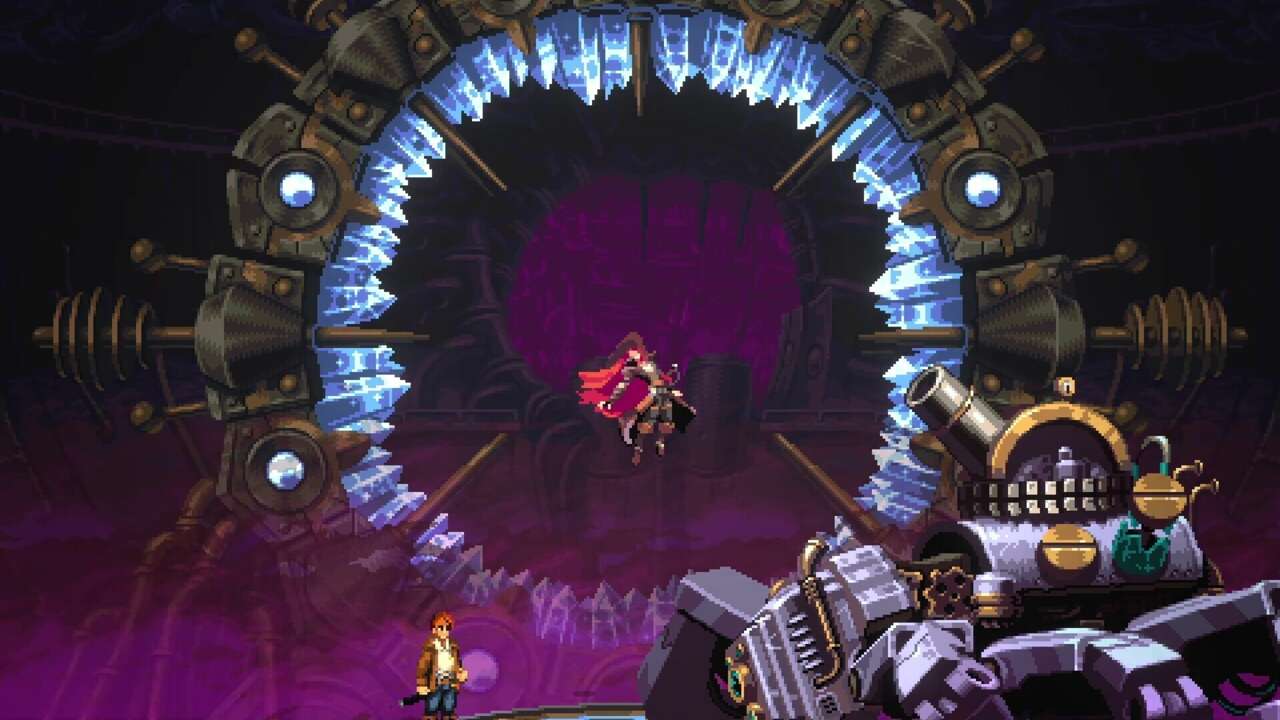More than almost any other genre, the metroidvania is reaching a saturation point. We have beloved modernizations like Hollow Knight and Axiom Verge and big-budget takes like Batman: Arkham Asylum or this year’s Prince of Persia: The Lost Crown, alongside a steady, constant drumbeat of indie releases. It’s hard to throw a rock at Steam without hitting at least a couple of metroidvanias, and with that much choice, it’s hard for any one to stand out. Gestalt: Steam and Cinder is the latest indie take on the genre, but it manages to do what many others don’t: pay homage to the two most prominent originators of the genre with smart, deliberate design choices that help it stand out in a crowded field.
In some sense, all metroidvanias combine aspects of Super Metroid and Castlevania: Symphony of the Night. Gestalt does so as well, but it also wisely leans on some of their best attributes, which feels like a conscious choice. For Super Metroid, that means a vast, interconnected world that is broken into a handful of distinct zones that play like their own stages. And like Symphony of the Night, it sports gorgeous pixel art with an emphasis on slick combat with light RPG hooks.
In Gestalt, you play as Aletheia, a no-nonsense bounty hunter who is on semi-friendly terms with the governing body of Canaan, a post-apocalyptic steampunk city. The world has recovered from the devastation of a war involving clockwork soldiers and cursed armor, but the stability is tense and everyone senses it’s coming to an end. You get the impression throughout that Canaan’s peacekeepers have tried to recruit Aletheia at various points, but she’s always preferred to go her own way because she is, above all else, a cool, independent protagonist. Taking bounties ultimately leads to trouble as she investigates the areas around Canaan for clues about what’s really going on.
Functionally, that means the map is separated into distinct zones that would feel right at home on Super Metroid’s planet Zebes. The areas are visually distinct from each other, and for the most part, you complete one “stage” before moving on to the next. You can still backtrack to older areas to reach new areas that you couldn’t before, but you won’t be criss-crossing between areas repeatedly. I found it a refreshing change of pace to have a slightly more structured metroidvania that minimizes backtracking between areas.
That said, the map is much less detailed than the grid-based one you’d find in Super Metroid and many games inspired by it. You won’t get the satisfaction of filling in every grid-chunk on a map. Despite that, I had no trouble finding my way around even when revisiting areas to find extra treasures, so the map did its job adequately.
That’s partly because exploration is not heavily emphasized in your abilities. Though you do get a handful of exploration-based abilities, most areas aren’t actually ability-gated. The ones you do get are likely what you’ve come to expect from a metroidvania, like a double-jump or an air dash. But those ability gates are smartly implemented into a large upgrade matrix. Instead of a starting point with branches like a tree, you can see the full suite of abilities from the start. As you get new ones throughout the story, they unlock nodes that generally correspond to the four corners, which lets you buy connecting abilities starting from that direction. Some of the strongest are at the midpoint between nodes and only unlock when you’ve approached from both sides. That lets the game dole out abilities at a deliberate pace, while also giving you a lot of control over your choices about which super-abilities you want to build towards.
And while it carries itself with a retro aesthetic, the combat mechanics had one noticeable modern touch. Given the look and feel of the game, I had tried to approach combat encounters by avoiding getting too close to enemies, assuming that pressing against them would cause me to suffer damage. But much like a 3D action game, that isn’t the case. You can hug enemies, roll right into them, strike, and then roll away. After a slight adjustment period, this felt very intuitive for the combat system, which is largely built around close-quarters attacks and dodge-rolling out of the way. (It is, however, somewhat odd to have a forward dodge-roll and a backward dodge-flip assigned to two different buttons, despite them functioning almost identically. I barely used the dodge-flip.)
Combat is also augmented by a long-range pistol, with extremely limited ammo that gets refreshed through building up energy with melee attacks. You can shoot a normal bullet, but the pistol’s special Tesla-infused bullets are necessary to stagger tougher, shielded enemies (as well as to charge certain electronic devices). Encounters are often a delicate balance of closing distance, attacking to build your meter, backing off to fire off a couple of debilitating shots, and then closing the gap to go in for the kill. It’s a thrilling dance, and made more so as you unlock more specialized abilities like charged shots or fiery, screen-filling melees.
Gestalt also implements a light equipment and item system, with accessories for stat bonuses and potions that give you temporary buffs. I hardly ever needed to use items outside of a refillable healing flask, but rejiggering my accessories frequently made a huge difference–especially once I began finding more parts to craft new and upgraded versions for them by doing side quests.

Thanks largely to the smart upgrade and equipment system, I found the combat difficulty to be a nicely inviting and smooth ramp, albeit one where the challenge didn’t quite scale to match my power. Near the beginning of the game, I was trying boss encounters at least a few times, and more often than not, grinding to unlock another few upgrade nodes before going back to try again. By the end, I was breezing through every boss on the first try without much difficulty. That makes the combat feel empowering, if not especially challenging as you near the end.
One aspect where Gestalt: Steam and Cinder should have borrowed more inspiration from its inspirations, though, is in its story presentation. Super Metroid is famously minimalist, telling most of its haunting story through silent vignettes. Symphony of the Night tells a more detailed story but does it through short, punchy and campy dialogue sequences. Gestalt by comparison is extremely lore-heavy, to the point that it sometimes bogs down the experience. Dialogue sequences are both overlong and dense, littered with proper nouns that make it difficult to track. I often wished for a glossary to refresh my memory about what various terms meant. By the end, I felt confident that I was understanding the general gist, but the story it was telling did not warrant the sheer volume of text.
However, the vast majority of my time was not spent wading through inscrutable dialogue. It was spent exploring a diverse steampunk world, mastering the surprisingly rich combat, and filling out the smartly-designed skill tree. Gestalt: Steam and Cinder is a joyful journey into nostalgic metroidvania action, and a great start for a potential franchise.






